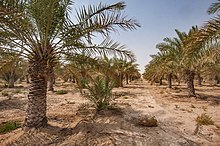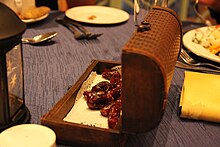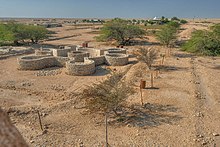
The history of Qatar spans from its first duration of human occupation to its formation as a modern state. Human occupation of Qatar dates back to 50,000 years ago, and Stone Age encampments and tools have been unearthed in the Arabian Peninsula. Mesopotamia was the first civilization to have a presence in the area during the Neolithic period, evidenced by the discovery of potsherds originating from the Ubaid period near coastal encampments.

Pearl hunting, also known as pearling, is the activity of recovering or attempting to recover pearls from wild molluscs, usually oysters or mussels, in the sea or freshwater. Pearl hunting was prevalent in the Persian Gulf region and Japan for thousands of years. On the northern and north-western coast of Western Australia pearl diving began in the 1850s, and started in the Torres Strait Islands in the 1860s, where the term also covers diving for nacre or mother of pearl found in what were known as pearl shells.

Zubarah, also referred to as Al Zubarah or Az Zubarah, is a ruined, ancient town located on the northwestern coast of the Qatar peninsula in the Al Shamal municipality, about 65 miles from the capital Doha. It was founded by Shaikh Muhammed bin Khalifa, the founder father of Al Khalifa royal family of Bahrain, the main and principal Utub tribe in the first half of the eighteenth century. It was designated a UNESCO World Heritage Site in 2013.

Al Wakrah is the capital city of the Al Wakrah Municipality in Qatar. Al Wakrah's eastern edge touches the shores of the Persian Gulf and Qatar's capital Doha is situated to the city's immediate north. Governed by Sheikh Abdulrahman bin Jassim Al Thani, it was originally a small fishing and pearling village. Over the years, it evolved into a small city with a population of more than 80,000 and is currently considered the second most populous city in Qatar.

The national emblem of Qatar is one of the official symbols of the state of Qatar. The emblem was initially adopted six years after the termination of the British protectorate, with the gained independence as a country under Sheikh Ahmad bin Ali Al Thani, and was designed under the reign the Emir of Qatar Khalifa bin Hamad Al Thani in 1976.
Al Jalahma is an Arab clan, based primarily in the Arab States of the Persian Gulf. They are derived from the `Anizzah tribe of Northern Central Arabia. They were one of the four Utub clans who founded the modern state of Kuwait in 1716, along with Al Bin Ali, Al Sabah and Al Khalifa.
Al Bin Ali is a Sunni Arab sub-tribal confederation based in the Arab states, especially in Bahrain, Qatar, Kuwait, UAE, and the Eastern Province of Saudi Arabia.

Khawr al Udayd, is a settlement and inlet of the Persian Gulf located in Al Wakrah Municipality in southeast Qatar, on the border with Saudi Arabia. It is known to local English speakers as the "Inland Sea". In the past it used to accommodate a small town and served as the center of a long-running territorial dispute between Sheikh Jassim bin Mohammed Al Thani and Sheikh Zayed bin Khalifa Al Nahyan. At the present, it is a major tourist destination for Qatar.

Ath Thaqab is an abandoned village in Qatar, located in the municipality of Ash Shamal, approximately 110 km away from the capital Doha. It is close to the settlements of Al Ruwaydah and Al Khuwayr, the latter of which is only 3 miles away. Thaqab Fort is located in the vicinity of the settlement.
The Bani Utbah is an Arab tribal confederation in the Arabian Peninsula. The confederation is thought to have been formed when a group of clans from Najd migrated to Eastern Arabia in the late 17th century and early 18th century. Most of the Utub clans and families, such as the Al-Sabah and Al-Khalifa, trace their lineage back to Anizah tribe, with the exception of some, such as the Al Bin Ali, whose lineage goes back to the Banu Sulaym tribe. The Al Bin Ali along with the current ruling families of Bahrain and Kuwait were the rulers of the federation. The name of the confederation is found in the form Attoobee or Uttoobee in English sources up to the late 19th century.

Al Khor is a coastal city in northeast Qatar, located 50 kilometres (31 mi) north of the capital Doha. Considered one of Qatar's largest cities, it is the capital city of the municipality of Al Khor and Al Thakhira. Dating back to the 18th century, it is one of Qatar's oldest settlements. The name of the city, meaning creek in Arabic, emerged because the original settlement was built on a creek. Until the mid-1900s, it was known as Khor Al Shaqiq.

The culture of Qatar is strongly influenced by traditional Bedouin culture, with less acute influence deriving from India, East Africa, and elsewhere in the Persian Gulf. The peninsula's harsh climate has historically shaped the lifestyle of its inhabitants, driving a reliance on the sea for sustenance and fostering a distinct emphasis on maritime activities within local culture. Arts and literature themes are often related to sea-based activities. Qatari folklore and music best enshrine the state's marine tradition, with pearling trips serving as the main inspiration for music and traditional Qatari myths like Mai and Ghilân being centered around the sea.

Simaisma is a small seaside town located on the eastern coast of Qatar 30 km north of the capital Doha. The town is characterized by old houses and mosques that are relics from the days before the discovery of oil and natural gas in Qatar.

The Qatari-Bahraini War, also known as the Qatari War of Independence, was an armed conflict that took place in 1867 and 1868 in the Persian Gulf. The conflict pitted Bahrain and Abu Dhabi against Qatar. The conflict was the most flagrant violation of the 1835 maritime truce, requiring British intervention. The two emirates agreed to a truce, mediated by the United Kingdom, which led to Britain recognizing the Al-Thani family of Qatar as the semi-independent ruler of Qatar. The conflict resulted in wide-scale destruction in both emirates.

The History of Bahrain (1783–1971) covers the history of Bahrain since the invasion of Al Khalifa until the independence from the British Empire.

Qatari cuisine is made up of traditional Arab cuisine. Machbūs, a meal consisting of rice, meat, and vegetables, is the national dish in Qatar, typically made with either lamb or chicken and slow-cooked to give it a depth of flavour. Seafood and dates are staple food items in the country. Many of these dishes are also used in other countries in the region because they share many commonalities. In other parts of the region, some of the dishes have different names or use slightly different ingredients. One proponent of the importance of Qatar's culinary heritage is chef Noor Al Mazroei, who adapts traditional recipes to include vegan and gluten-free alternatives.

Baladna is a Qatari agricultural company that raises livestock and produces dairy products. It is Qatar's largest locally-owned food and dairy producer, supplying over 95% of the country's fresh dairy products.
The Na'im is an Arab tribe in the United Arab Emirates. The tribe is also present in other gulf countries.
The AlManasir is a tribe of the United Arab Emirates (UAE). Nomadic, warlike and fiercely independent, they roamed between Buraimi and Qatar, the Persian Gulf coast to Liwa and also settled in the Northern emirates. They subsisted through date farming, pearling and moving goods with their camel trains, as well as camel breeding.
Al Huwaila is an abandoned town in Qatar located in the municipality of Al Shamal. Prior to the 18th century, and as perhaps as early as the 16th century, it served as Qatar's main town before its population migrated elsewhere.


















